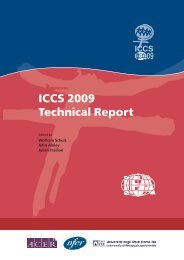Teacher Education and Development Study in Mathematics - IEA
Teacher Education and Development Study in Mathematics - IEA
Teacher Education and Development Study in Mathematics - IEA
Create successful ePaper yourself
Turn your PDF publications into a flip-book with our unique Google optimized e-Paper software.
54<br />
TEACHER PAY AND STUDENT MATHEMATICS ACHIEVEMENT<br />
Tables 12 <strong>and</strong> 13 show that the mean weekly <strong>in</strong>comes for male teachers <strong>in</strong> both 1996<br />
<strong>and</strong> 2001 were considerably below the mean weekly <strong>in</strong>comes for males <strong>in</strong> other<br />
mathematics- <strong>and</strong> science-oriented occupations <strong>and</strong>, <strong>in</strong>deed, <strong>in</strong> all other occupations<br />
employ<strong>in</strong>g males with Bachelor’s degrees. 7 The difference between the occupational sets<br />
was somewhat smaller <strong>in</strong> 2001 than <strong>in</strong> 1996. There was very little difference across both<br />
years <strong>in</strong> terms of whether the <strong>in</strong>dividuals held a Bachelor’s degree or a postgraduate<br />
degree. The mean weekly <strong>in</strong>comes of female teachers were also lower than the mean<br />
weekly <strong>in</strong>comes for females <strong>in</strong> other mathematics/science professions <strong>in</strong> both years, but<br />
female teachers with a Bachelor’s degree earned more than females with a Bachelor’s<br />
degree work<strong>in</strong>g <strong>in</strong> other professions.<br />
<strong>Teacher</strong>s with postgraduate degrees earned lower weekly <strong>in</strong>comes than both mathematics<br />
<strong>and</strong> science professionals <strong>and</strong> females <strong>in</strong> other professions. This situation was evident<br />
<strong>in</strong> both 1996 <strong>and</strong> 2001. A female teacher with a Bachelor’s degree, 30 to 34 years of age,<br />
earned about one-third less than a female of the same age with a Bachelor’s degree <strong>in</strong> a<br />
mathematics/science profession <strong>in</strong> both 1996 <strong>and</strong> 2001. Although this difference varied<br />
somewhat for different ages <strong>and</strong> for different levels of education, these teachers received<br />
lower rates of pay than their counterparts <strong>in</strong> mathematics <strong>and</strong> science professions, <strong>and</strong><br />
the difference was fairly large.<br />
The data on median <strong>in</strong>comes presented <strong>in</strong> Figures 2 to 5 confirm these patterns.<br />
Table 12: Australia, Mean Weekly Earn<strong>in</strong>gs of Males <strong>and</strong> Females <strong>in</strong> <strong>Mathematics</strong>/Science<br />
Occupations <strong>and</strong> Teach<strong>in</strong>g, by Level of <strong>Education</strong> <strong>and</strong> Age, 1996<br />
Males with Bachelor’s Degree, 1996 Females with Bachelor’s Degree, 1996<br />
Age Maths/Science <strong>Teacher</strong>s All Other Maths/Science <strong>Teacher</strong>s All Other<br />
Occupations Occupations Occupations Occupations<br />
20–24 650 524 506 607 516 475<br />
25–29 851 647 741 772 612 630<br />
30–34 1,015 767 916 838 647 665<br />
35–44 1,065 833 991 816 675 652<br />
45–54 1,077 858 1,025 823 746 678<br />
55–64 993 793 952 734 734 629<br />
Males with Postgraduate Degree, 1996 Females with Postgraduate Degree, 1996<br />
Age Maths/Science <strong>Teacher</strong>s All Other Maths/Science <strong>Teacher</strong>s All Other<br />
Occupations Occupations Occupations Occupations<br />
20–24 622 548 503 613 541 479<br />
25–29 826 639 728 734 592 625<br />
30–34 997 742 896 835 635 680<br />
35–44 1,054 824 974 844 668 676<br />
45–54 1,050 848 997 839 740 720<br />
55–64 984 795 917 842 686 657<br />
Source: Australian Bureau of Statistics (1996). Income variable <strong>in</strong>dicates the gross <strong>in</strong>come (<strong>in</strong>clud<strong>in</strong>g<br />
pensions <strong>and</strong> allowances) that the person usually receives each week. Applicable to persons aged 15 years<br />
<strong>and</strong> over.<br />
7 The most recent census survey is for 2006, but this <strong>in</strong>formation was not available <strong>in</strong> late 2006 when we made these<br />
estimates. We expect, however, that little change <strong>in</strong> relative <strong>in</strong>comes occurred between 2001 <strong>and</strong> 2006.

















